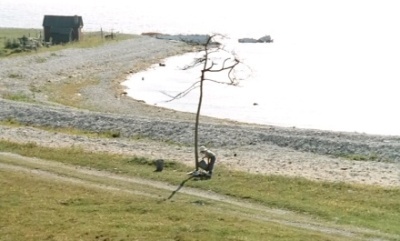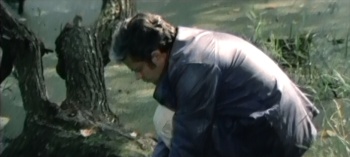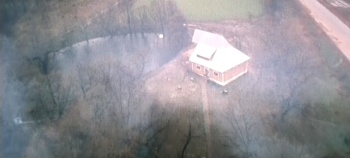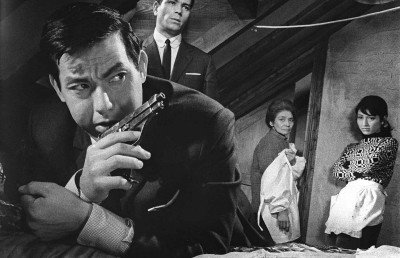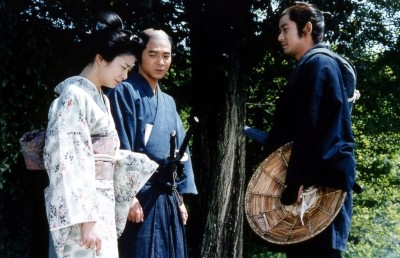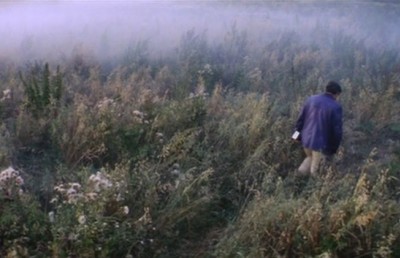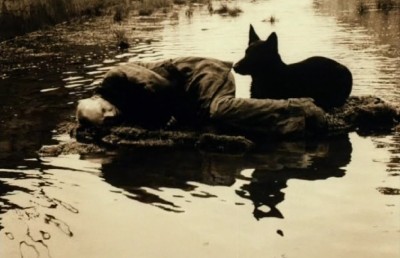Ivan’s Childhood: The Tree of Life
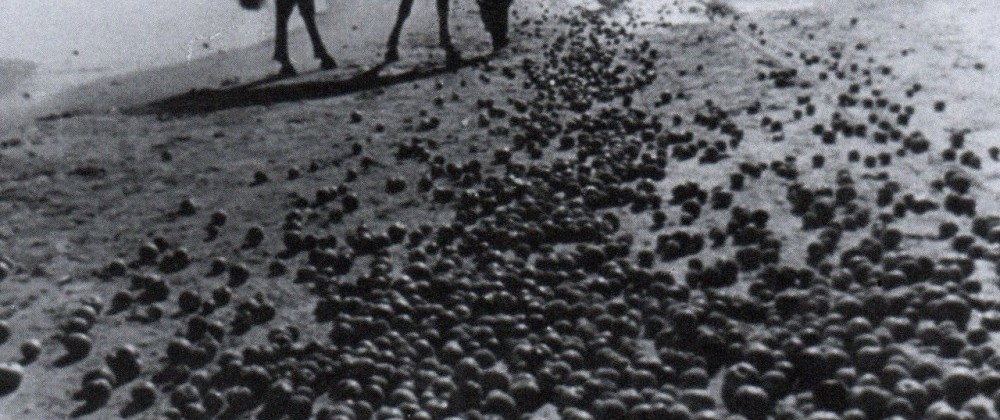
In the essay entitled “Nature as ‘Comfort Zone’ in the Films of Andrei Tarkovsky” in the last issue of Offscreen I discussed the unique manner in which Tarkovsky situates nature as an arena of respite from all forms of emotional and physical pain. One of the films I analyzed closely was Ivan’s Childhood, a film I have seen many times before writing that essay. I watched the film again after posting the essay and was struck by how a single aspect of nature, the tree, is so deeply engrained in the film’s overall structure and theme of innocence lost (in the case of the lead character, 12 year-old Ivan, and his forced entry into adulthood). As a manifestation of the theme the film is largely structured around a series of dualities that set in opposition the horrible reality of war-time Russia and the idealism of childhood innocence expressed largely through Ivan’s dreams, but also selected moments of naivety reflected in the young love experienced by the attractive young female doctor Masha. Nature, but more specifically the tree, is often at the core of this duality. I would like to delineate this important use of the tree across the film as an addendum or extension of my earlier essay.
Many people have noted the self-conscious structural symmetry found in Tarkovsky’s oeuvre in the form of crane shots of a tree that open his first film Ivan’s Childhood and close his final film The Sacrifice. The same occurs within Ivan’s Childhood, where the book-ending of shots serves the thematic meaning of the film. The film opens with a close-up of Ivan standing behind a tree. In comparison to many other trees seen in the film, this one is very thin, which parallels Ivan’s own lithe body (see still further below). The camera cranes up to the top of the tree, as Ivan becomes visible walking along a dirt road in the background (this blocking of the action will be repeated in reverse in the first scene after this dream). Ivan begins to run through the grass. This cuts to Ivan’s point of view of a butterfly, the camera’s movement suggestive of the fluttering movement of the butterfly. This shot is followed by shots of Ivan seemingly taking to the air in chase of the butterfly, flying through the tree tops (to achieve this convincing illusion of dream flight I imagine that Tarkovsky had actor Nikolai Burlyaev stand on the camera crane).
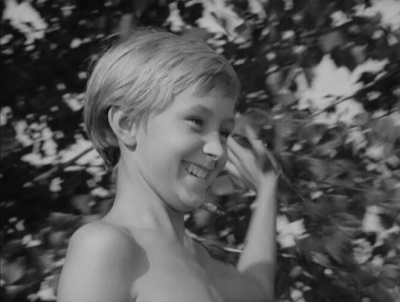
In a foreshadowing of the opening balloon flight in Andrei Rublev, Ivan rises and then comes gently crashing down to the ground (with vertiginous point of view aerial shots charting his flight down, as in Rublev). A hidden cut on the movement of the camera shifts us spatially from the air to below ground level, the camera now inside a type of trench, with the camera tracking slowly along a rocky, earthy, clay-like wall. Along the way we see tree roots periodically sticking out from the earth wall, before stopping at a close-up of Ivan. In a subtle touch that only the most observant viewers will see, a butterfly camouflaged by its color is perched on the branch next to Ivan (this effect of camouflaging by tone, light, color and texture foreshadows the ‘hidden’ angels in the Passion scene in Andrei Rublev). The effect is as if Ivan has somehow burrowed himself several feet below ground, having caught up with the butterfly, now resting on a darkened tree branch. By shifting the perspective from tree, to sky, to below ground Tarkovsky establishes the bond that exists between tree/sky/earth: while a tree’s roots are firmly and deeply connected to the earth, its branches reach skyward. A tree is at once material and spiritual.
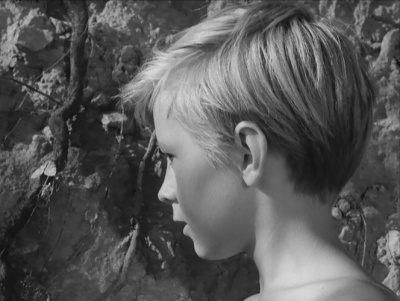
Once Ivan awakens from his dream, he exits a windmill and makes his way through a stark river forest, the trees tall and dark. This river forest is one of the central locations of the film, essentially where Ivan plies his reconnaissance trade, crossing back and forth across enemy German lines to help chart military strategy. It is where Captain Kholin and Lieutenant Galtsev escort Ivan to, and where corpses of other Russian soldiers lay hanging on branches, where we see German soldiers for the only time in the film, and where danger lurks at every corner. The location is sinister, threatening, yet not without its own dark, expressionist beauty. This location, associated with the war, danger, death, and men, stands in stark contrast to another forest which makes its appearance in the film some thirty minutes later, the white birch tree grove, which is associated with innocence, puppy love, beauty, lightness, and, through Masha, woman.
The scenes set in and around the beautiful white birch tree grove may be physically connected to the scenes of the war arena, but emotionally feel hundreds of miles removed from the horrors of war. The long sequence of the birch tree grove that runs from approximately 32” to 41” is set off from the rest of the film by edits from and to muddy, non-vegetative landscape imagery that is diametrically opposed to the naturally splendorous birch tree grove. The scene before the birch tree grove begins on a close-up of Ivan seated in the back of an army truck, crying after being scolded by his superiors for his stubborn refusal to join a school. This cuts to a shot taken from a moving vehicle gazing at the colorless muddy terrain surrounding the military post. This moving shot cuts on the same right to left movement to a slightly slower paced movement in the same direction of the white birch tree grove. When the scene ends some nine minutes later it cuts back to a panning shot of a similarly dreary, muddy terrain. The contrast reflects this duality between the horrors of war and the escapist fantasy/dream reality.
From this….
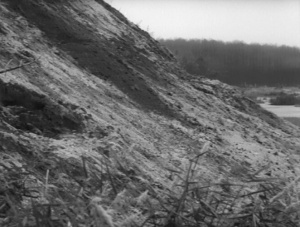
To This….
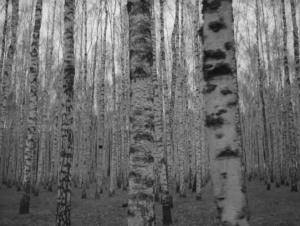
Of course the birch tree grove is not exactly a dream or fantasy, but the light-hearted subject –the young Masha being seduced by the older Captain Kholin– and enchanted style –marked by the constant ambient sound of a cuckoo bird and the subjective hand-held point of view shots of Masha moving through the forest with the lightness of a butterfly– make it feel far removed from the war .
Another telling edit in the birch tree grove sequence is the one that brings us from the opening lateral tracking shot of the white birch forest to the interior of the nearby cottage, which just happens to be made out of the same white birch tree logs. In the cottage Galtsev is questioning the pretty young female doctor Masha. The formal and textural match from the outside forest to the interior cottage will become a common Tarkovskian visual metaphor for the slippage between interior subjective states and exterior objective states of reality. As I explained in an earlier essay,
The play that exists in Tarkovsky’s films with interiors and exteriors reflects the inner/outer, mental/physical duality of his aesthetics. His films contain countless examples of locations that are in a state of limbo between interior and exterior. Rain and snow spontaneously fall inside churches, houses, hotel rooms and makeshift dwellings. …
This teetering between levels of reality is a central aspect of Tarkovsky’s aesthetics. The psychological grounding for it is the human mind: free-flowing conscious states, memories, visions, reflections, dreams. The physical grounding is nature. Together they form the inner/outer surface distinction of Tarkovsky’s world (Totaro, p. 27-28).
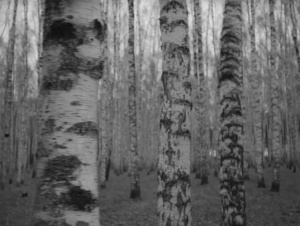
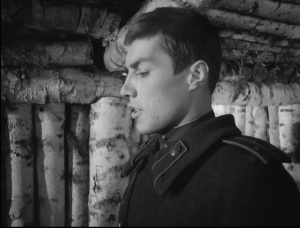
Although the white birch tree scene only comes into the film rather late, the singular birch tree makes a much earlier appearance: moments before Ivan’s second dream (approximately sixteen minutes). Ivan has just taken a bath, falls asleep and is carried to his bed by Galtsev. The camera tilts down from the fireplace and begins to track left, passing over several white birch logs, before cutting to a close-up of Ivan’s hand jutting out from the bedposts. A clever cut takes us into Ivan’s dream. By association, the birch tree is here tied to Ivan’s dream world. It appears again in the same space, again tied to Ivan, at around the hour mark, in a scene where Ivan conspicuously carries around a single birch tree log under his arm during a discussion with Galtsev (who is seen in a mirror reflection). The way Tarkovsky has the actor cling to the log suggests that it carries some importance, either as an indication of Ivan’s single-mindedness, or, more likely, a symbol of his lost youth/innocence.
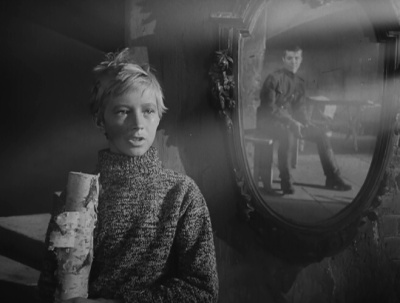
Tied more to Ivan’s nightmare world is the scene where Ivan comes across an elderly widower, living in the charred remains of his home, psychically broken by the death of his wife. Tarkovsky was on record disliking this scene because of its obvious symbolism of war-as-hell/the home-front-as-emotional wasteland , but beyond the obvious imagery (like the first shot of Ivan walking under a dangerous web-like pattern of jagged slats of wood, which, in a more subtle vein, echoes the opening shot of Ivan standing behind a spider web on a branch), Burlyaev’s performance as a young boy who empathizes with the old man and connects with his sense of loss saves the scene from its more forced expressionism. The charred tree stubs, ominous dark smoke clouds hovering in the far background, and muddy terrain represent the war’s onslaught on nature. Tarkovsky even places a dried-up well to contrast the functioning well scene in Ivan’s contrarily idyllic (for the most part) dreams.
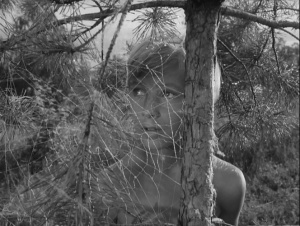
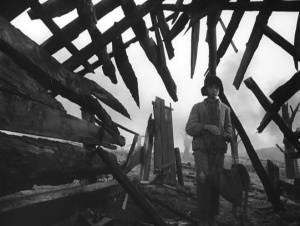
Stop the film at almost any moment and you will find a tree (or trees) appearing as a striking visual signpost; at times simply to add visual interest, but more often to invoke a religious or spiritual tone, or a thematic/narrative meaning. Like the shot of Captain Kholin framed in low angle sandwiched between a lit tree stub and a Virgin and Christ Child icon (the juxtaposition suggestive of a church); the shot of the two dead Russian soldiers hanging from a branch in the forest river; the gothic-like trees jutting out of the forest river in the scene where Kholin and Galtsev escort Ivan to the front; and their echo in the tree-like twisted iron seen in the German records office where Galtsev finds Ivan’s death record; or the tree that surprisingly crashes into the forest river during the escort of Ivan to the Front.
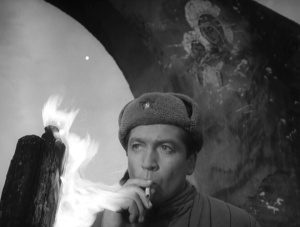
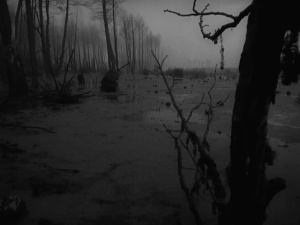
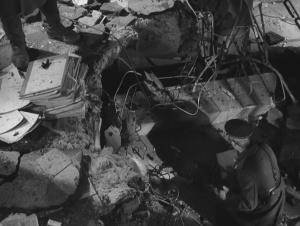
The final dream scene –either Ivan’s posthumous dream, or a dream as imagined by Galtsev– offers an almost ideal depiction of childhood, with Ivan and his sister playing a game of hide and seek with friends, along a white sandy beach, replenished by the sunshine reflecting off the ocean water. The only blemish to the dream is the single charred black tree that stands ominously (and quite impossibly) in the middle of the beach; the tree acts as reality’s reminder of the real world beyond the dream world. As if to underscore the strangeness and importance of the tree, Tarkovsky ends the film with a quick, unsteady track-in to the bark of the tree (which is preceded by a kinetic tracking shot following Ivan running along the beach with his arm outstretched). As Mark Robinson notes, “…the tree at the end of Ivan’s Childhood is a dead, charred, branchless trunk, like the dead tree in Waiting for Godot, a symbol of the natural world ruined by humanmade war” (Jeremy Mark Robinson, “The Sacred Cinema of Andrei Tarkovsky” p. 325).
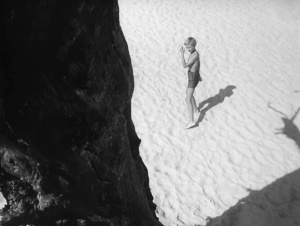
Tarkovsky’s depiction of the tree in Ivan’s Childhood can be broken down into two general aesthetic representations which reflect the film’s over-riding thematic duality: the white birch tree (which represents the ‘comfort zone’ side of nature, a sanctuary from the war, and the ‘dream’ of ‘innocence lost’) and the black or bare, charred tree (which represents the ugliness of the war, the physical state of war-time, and the madness of war).
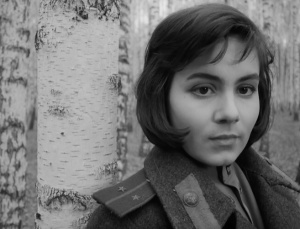
Masha and the Innocence of the Birch Tree
As I noted in “Nature as ‘Comfort Zone’ in the Films of Andrei Tarkovsky,” the tree is only one of many signifiers of nature (water, fire, rain, snow, wind, etc.) that Tarkovsky employs across all his films. I have focused on Ivan’s Childhood because the tree has such a large function in the film’s thematic meaning, more so than in any of his other films; but the tree plays a key role across other Tarkovsky films. I’ll conclude by citing just a few examples. Given its symbolic resonance to Ivan’s Childhood , in the way it forms a book-end with the first/last shot, The Sacrifice is perhaps the film after Ivan’s Childhood which uses the tree to the greatest narrative and thematic significance.
Like Ivan’s Childhood, the tree, which acts as a powerful bond between father and son, who plant a Japanese tree together, appears in both the opening and closing shots of the film. In fact the tree makes a ‘double’ appearance in the opening of The Sacrifice. We first see a tree in the Leonardo Da Vinci’s painting Adoration of the Magi seen behind the credit roll, with the camera craning up the full length of Da Vinci’s tree, a gesture which in fact foreshadows the final shot, and then we see a Japanese tree in the first image of the film, seen in extreme long shot with the Erland Josephson character Alexander watering the base of the tree. The film ends with the now famous final (of his career) shot of the camera craning up to the top of the Japanese tree.
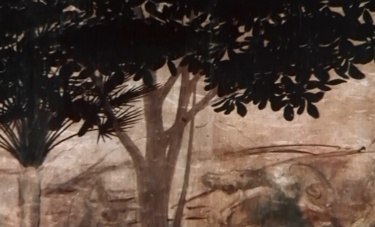
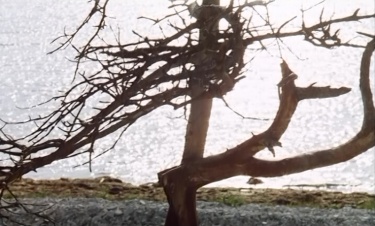
Near the end of Andrei Rublev, after the young bell-caster’s son Boriska’s (played by the same Nikolai Burlyaev) manic commandeering of a bell casting mission proves successful, we discover that his claim of having his father’s “bell-casting secret” was all a ruse and that this massive task was largely achieved by intuition. The previously callous, driven, and supremely confident Boriska now appears like a terrified young boy, wrapping his emotionally and physically spent body around a birch tree stump and whimpering like baby. He is comforted by Andrei Rublev, who has his faith in art and humanity shaken back into him by Boriska’s selfless at of creation. Rublev takes Boriska into his arms and breaks his long vow of silence, telling Boriska that they will travel to Moscow, casting bells and painting icons together. It is one of the most genuinely touching moments in a Tarkovsky film, foreshadowing the father/son/tree triad of The Sacrifice.
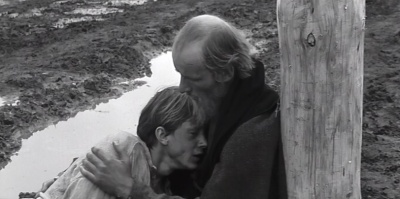
Trees are also featured in the opening (if we discount the pre-credit documentary footage of the speech therapist) and closing shots of Mirror. The post-credit scene begins with a long shot of Maria seated on a wooden fence, looking longingly into the green space ahead of her. Her figure is framed on all sides by trees. The camera dollies forward grazing past a branch in the process and past the woman to frame a man walking in the distance. The final scene takes place in the same location as the opening, the green space surrounding the dacha, and the film ends, literally, in a dark forest of trees. In Robinson’s discussion of trees and forests he rightly invokes Dante’s Divine Comedy (p. 180):
In the middle of life’s path
I found myself in a dark forest
Where the straight way was lost…
(Inferno, 1: 1-3)
A Dantean meaning is perhaps most invoked in the emotionally devastating (at least for this viewer) final scene in Mirror where (possibly) the narrator’s posthumous memory takes us back to the early days before his life began, with his young mother and father lying in the grass discussing his imminent birth (“Would you rather have a boy or a girl? asks the father). The young mother looks back from her lying position to the forest behind them, forming a Kuleshovian eye-line glance as she seemingly looks into her own future. In a clearing in the forest different time chronologies featured across the film (1930s and 1970s) meld into one, with the mother aged from the 1970s walking hand in hand with the narrator and his sister aged from the 1930s (making the mother seem like a grandmother).
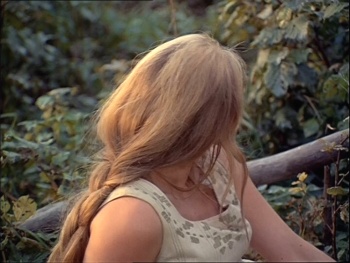
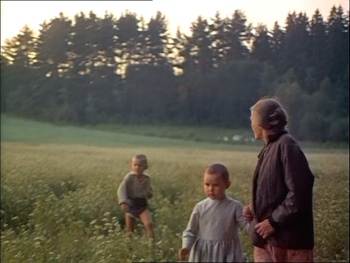
As the older mother walks into the distance with Alexei as a boy and her sister the film ends with the camera tracking left (with the odd zoom-in) at a diagonal into the increasingly thicker part of the forest, ending in near darkness. Given the temporal properties of the scene’s spatial architecture spanning the early 1930s (pre-birth of the narrator) to 1970s (the death of the narrator), the forest may very well be read as the equivalent of Dante’s “life’s path.” Above all else, the tree for Tarkovsky symbolizes life itself, moving forward (downward and upward to be more accurate) amidst all form of adversary. In The Sacrifice, where trees are seen in practically every exterior shot, the son continues the watering of the Japanese tree after his father is taken away to a sanitarium (literalizing it as a ‘family tree’).

